-
Welcome to ASR. There are many reviews of audio hardware and expert members to help answer your questions. Click here to have your audio equipment measured for free!
You are using an out of date browser. It may not display this or other websites correctly.
You should upgrade or use an alternative browser.
You should upgrade or use an alternative browser.
Tripp Lite IS250 Review (Isolation Transformer)
- Thread starter amirm
- Start date
- Joined
- Sep 21, 2021
- Messages
- 390
- Likes
- 210
I wonder if PS Audio's or Audioquest's PowerStations meet code or life safety standards...That may be even more dangerous the 115:115 is bonded on both sides. Bonding the N is safer.
That is why it is standard practice. Do what you like but I am advising others not to cut the N to your transformers.
Dangerous and no benefit.
The device is Certified, not Listed.
It does not meet Code and safety standards.
Not really aiming that at you, just made me think about that.
I doubt it, it is expensive. They also use 20 A receptacles.I wonder if PS Audio's or Audioquest's PowerStations meet code or life safety standards...
Not really aiming that at you, just made me think about that.
Isolation transformers are less safe. They are intended for use where you CAN'T ground for some reason.
Test instruments
Labs
Sensitive equipment.
Where cables and such are being handled in wet environments or not practical to derive a ground.
Typically a controlled environment.
They are not safer.
Bonded with GFCI is.
There are hazards associated with them.
If you have a short you do not know it.
If you pinch L and N the secondary will cook depending on fault Z.
You may also damage the load, the N may become elevated and in some gear current will flow in the primary, inducing current in the secondary, which is center tapped.
Not you have a current loop thru the frames.
That is why the safety standard is to bond unless you have a reason not to but there are increased risk.
- Joined
- Sep 21, 2021
- Messages
- 390
- Likes
- 210
Yeah my education is in electrical engineering, so I know what you're saying. It's definitely *not* a safety concern being addressed by these isolation transformers from Tripplite, unless there's a model I'm not aware of (and frankly I'm not really all that motivated to go and look :-D ).I doubt it, it is expensive. They also use 20 A receptacles.
Isolation transformers are less safe. They are intended for use where you CAN'T ground for some reason.
Test instruments
Labs
Sensitive equipment.
Where cables and such are being handled in wet environments or not practical to derive a ground.
Typically a controlled environment.
They are not safer.
Bonded with GFCI is.
There are hazards associated with them.
If you have a short you do not know it.
If you pinch L and N the secondary will cook depending on fault Z.
You may also damage the load, the N may become elevated and in some gear current will flow in the primary, inducing current in the secondary, which is center tapped.
Not you have a current loop thru the frames.
That is why the safety standard is to bond unless you have a reason not to but there are increased risk.
Safety:
Medical isolation transformer box is certified to UL 60601-1, 2nd edition medical standard and
CSA-C22.2.No. 601.1M90, 2005
UL: (E352717), UL60601-1, 2nd edition and CAN/CSA-C22.2 No. 601.1M90, 2005
The device is Certified, not Listed.
- North American Mark of Safety - C UL & UL listed (File #E211544)
- Floating AC output
- Full UL 60601-1 medical-grade listing with hospital-grade plug and outlet receptacles for the protection
of sensitive electronic equipment in patient-care areas
And what did armin say about posting unnecessary(large) pictures...
they also have some with "real isolation" PE is connected to PE but not to secondary NIt's definitely *not* a safety concern being addressed by these isolation transformers from Tripplite, unless there's a model I'm not aware of (and frankly I'm not really all that motivated to go and look :-D ).
The reviewed product is UL Listed, I'll give that. From the videos Amir posted the secondary N is bonded. It would have to be to be listed. So not a true isolation xfmr. There is a DYI video with the guy showing how to disconnect the N from frame. wth lolYeah my education is in electrical engineering, so I know what you're saying. It's definitely *not* a safety concern being addressed by these isolation transformers from Tripplite, unless there's a model I'm not aware of (and frankly I'm not really all that motivated to go and look :-D ).
I looked a a few specs for PS Audio products no mention of listing.
Yes
- North American Mark of Safety - C UL & UL listed (File #E211544)
- Floating AC output
- Full UL 60601-1 medical-grade listing with hospital-grade plug and outlet receptacles for the protection
of sensitive electronic equipment in patient-care areas
And what did armin say about posting unnecessary(large) pictures...
they also have some with "real isolation" PE is connected to PE but not to secondary N
Certified for use in a hospital under proper maintenance and control.
They are listed for residential use.
But that does not make them safer.
They assume the increased risk because of the load. Continuity of service. Not safety.
From cut sheet
Please refer to instruction manual for safety precautions.
FYI
the the xfmrs that feed the circuits those boxes are plugged into are bonded to G, not floating or isolation type. They may have an isolated ground but it is STILL bonded to N.
Why don't they make all circuits ungrounded?
It's safer?
Last edited:
Geert
Major Contributor
- Joined
- Mar 20, 2020
- Messages
- 2,237
- Likes
- 4,492
My interpretation of this misunderstanding. A transformer with ungrounded secondary is safer in a "simple fault" situation. This means you can safely touch one of the secondary leads, as when you do so no current will flow. That's why these types of transformers are used in labo's and hospitals. It's what's depicted in this diagram (and lots of similar one's):
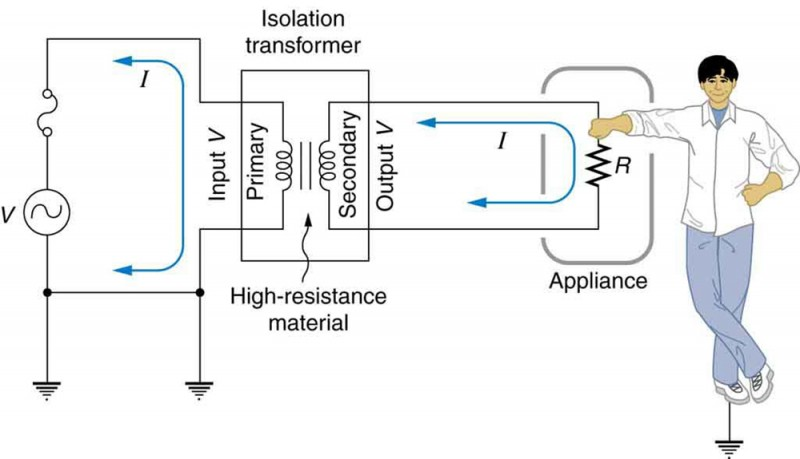
The risk is that the device connected to the secondary develops a ground fault (live wire short to device chassis), which you might not be aware of since you won't get a shock. When this happens and you touch the device chassis and the other secondary lead you will get a shock, and the primary circuit breaker won't trip. This is dangerous of course, so unsafe. It's why this solution when used in hospitals requires an IMD, a device which notifies you when a ground fault exists so it can be fixed ASAP.

The risk is that the device connected to the secondary develops a ground fault (live wire short to device chassis), which you might not be aware of since you won't get a shock. When this happens and you touch the device chassis and the other secondary lead you will get a shock, and the primary circuit breaker won't trip. This is dangerous of course, so unsafe. It's why this solution when used in hospitals requires an IMD, a device which notifies you when a ground fault exists so it can be fixed ASAP.
Last edited:
Amir fails to notice and mention that the transformer secondary N is bonded to ground.Amir posted the secondary N is bonded. It would have to be to be listed.
later after linking that video to him swing they are :I didn't and it isn't. I did explain in the video review how they are tied together at your breaker panel.
This now is till now not mentioned in the review?!Ah, I stand corrected. I don't know why they are doing that.
This would be the first fault. and you would not get a shock.The risk is that the device connected to the secondary develops a ground fault (live wire short to device chassis), which you might not be aware of since you won't get a shock.
Are you assuming chassis is connected to PE?When this happens and you touch the device chassis and the other secondary lead you will get a shock,
So to get a shock you need 2 independent faults.
First fault "secondary develops a ground fault(connection)"
Second fault "you touch the other secondary lead"
(At least here all devices make it as hard to touch the N as they make it to touch L since plugs can be reversed, both L and N are consider potentially Hot and double insulated.)
if current would be high maybe the breaker would trip. but not a levels save for human.and the primary circuit breaker won't trip.
the "rcd" won’t trip but the RCD also won't trip if secondary is coneted N is conected to PE?! (like in this tripp-lite transformer)
Now lets consider the case of a transformer with its secondary "N" Connected to PE:
Waht was the first fault in the first scenario is now the default. the secondary is concrete to PE and there by also to the chassis.
Now this is the first an only fault: When you touch the device chassis and the secondary L lead you will get a shock.
and the primary circuit breaker won't trip.
That's wonderfulAmir fails to notice and mention that the transformer secondary N is bonded to ground.
later after linking that video to him swing they are :
This now is till now not mentioned in the review?!
This would be the first fault. and you would not get a shock.
Are you assuming chassis is connected to PE?
So to get a shock you need 2 independent faults.
First fault "secondary develops a ground fault(connection)"
Second fault "you touch the other secondary lead"
(At least here all devices make it as hard to touch the N as they make it to touch L since plugs can be reversed, both L and N are consider potentially Hot and double insulated.)
if current would be high maybe the breaker would trip. but not a levels save for human.
the "rcd" won’t trip but the RCD also won't trip if secondary is coneted N is conected to PE?! (like in this tripp-lite transformer)
Now lets consider the case of a transformer with its secondary "N" Connected to PE:
Waht was the first fault in the first scenario is now the default. the secondary is concrete to PE and there by also to the chassis.
Now this is the first an only fault: When you touch the device chassis and the secondary L lead you will get a shock.
To everyone else not hell bent on electrocuting someone or burning your house down a bonded neutral is safer and the standard except for some limited applications.
NEC, NESC, UL, NEMA, engineers, insurance companies, Factory Mutual
By some folks logic:
Go to your service panel:
Remove the N to G bonding jumper
Disconnect to grounding electrodes
Go to your service xfmr
Disconnect ground
" it's safer "
btw: it's not
If the N is is not bonded the primary CB will NOT trip. No matter high the sec I is.
>infinite zero seq Z There is no Inpath, it is 'isolated', that is how the 'noise' is abated.
My gawd
It will trip in the Triplite
Last edited:
Geert
Major Contributor
- Joined
- Mar 20, 2020
- Messages
- 2,237
- Likes
- 4,492
I indeed describe a dual fault scenario. Chassis in contact with a secondary lead because of a fault, and user touches chassis and the other secondary lead. The user is now 'under power'. With double insulated appliances this is less likely to happen (as long as you're just using the appliances as intended, not when you're servicing them).Are you assuming chassis is connected to PE?
So to get a shock you need 2 independent faults.
First fault "secondary develops a ground fault(connection)"
Second fault "you touch the other secondary lead"
Indeed. In a system without an isolation transformer the RCD would trip immediately. If secondary N is connected to PE the RDC wouldn't trip either I believe, as at primary side there's no current loss to ground. However:if current would be high maybe the breaker would trip. but not a levels save for human.
When the secondary N of the isolation transformer is connected to PE the primary circuit breaker would trip on the 'first fault', where the secondary L develops a ground fault.Now lets consider the case of a transformer with its secondary "N" Connected to PE
I indeed describe a dual fault scenario. Chassis in contact with a secondary lead because of a fault, and user touches chassis and the other secondary lead. The user is now 'under power'. With double insulated appliances this is less likely to happen (as long as you're just using the appliances as intended, not when you're servicing them).
Indeed. In a system without an isolation transformer the RCD would trip immediately. If secondary N is connected to PE the RDC wouldn't trip either I believe, as at primary side there's no current loss to ground. However:
When the secondary N of the isolation transformer is connected to PE the primary circuit breaker would trip on the 'first fault', where the secondary L develops a ground fault.
The RCD would not trip. In either case.
It is isolated in both, separately derived ground, except one doesn't have it.
That is why in the examples it's on the sec AND there is a high Z connection to the other leg.
You get it
The primary will trip before it becomes an issue.
In a non-grounded sec you are likely to damage both lines, as in a cord, so current will circulate. Until it reaches a high enough level to trip the primary.
Until then it will likely arc/spark unnoticed.
Not good. If bonded to N you have // paths and are more likely to trip much faster.
If the isolation xfmr is contained within the frame of the equipment it powers much less risk. I imagine most hospital equipment is designed this way.
My Luxman looks like it has an isolation xfmr of sorts. The only reference to frame for the power amp section is the speaker negative.
It is a double insulated design, L/N no G.
My Luxman looks like it has an isolation xfmr of sorts. The only reference to frame for the power amp section is the speaker negative.
It is a double insulated design, L/N no G.
In the NEC the only place isolation xfmrs are addressed is section 527 Healthcare Facities. The definition only states 2 winding inductively coupled. It does not address grounding in the definition. This makes obvious sense: ALL 2 winding xfmrs are electrically isolated.
The previously posted Bender IMD stuff relates to this. The <1 mA, etc. The limiting R can be in the relay or external but there MUST BE an intentional fault path to ground, not coupling C or insulation value.
This is not in a home, but a controlled, maintained environment. They HAVE to do this because they can't use the safer method of bonding due to operational needs, NOT safety. They must add IMD's etc. to offset the INCREASED RISK.

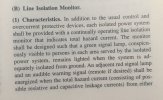
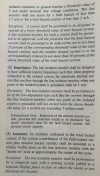
The previously posted Bender IMD stuff relates to this. The <1 mA, etc. The limiting R can be in the relay or external but there MUST BE an intentional fault path to ground, not coupling C or insulation value.
This is not in a home, but a controlled, maintained environment. They HAVE to do this because they can't use the safer method of bonding due to operational needs, NOT safety. They must add IMD's etc. to offset the INCREASED RISK.



For clarification as was claimed, these are NOT Class 1, 2 or 3 power limited sources in any useful manner.
Class 1 <30 V
Class 2, 120 V
Max I = 5 mA, VA = 6, the lower applies
Class 3, 120 V
1 A , 100 VA, the lower applies
And the device must be listed for such use.
I have no dog in this fight. I do not want someone to make a decision based on mis-applied information in the quest for better hifi at the risk of diminished safety. The kicker is, it provides no audible benefit.
The Code applies, bond the N, unless excepted. Class x, healthcare, testing, etc. imo these do not apply.
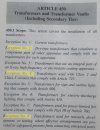
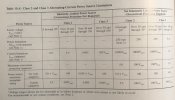
Class 1 <30 V
Class 2, 120 V
Max I = 5 mA, VA = 6, the lower applies
Class 3, 120 V
1 A , 100 VA, the lower applies
And the device must be listed for such use.
I have no dog in this fight. I do not want someone to make a decision based on mis-applied information in the quest for better hifi at the risk of diminished safety. The kicker is, it provides no audible benefit.
The Code applies, bond the N, unless excepted. Class x, healthcare, testing, etc. imo these do not apply.


My two cents to help reducing that server bill.You two are costing me a fortune in server costs to maintain those images.I suggest each of you make a summary post of your position and call it done after that.
The majority of images posted in this thread are formulas or schemes, which can be represented very cheaply in vectorial or other formats, svg for instance.
Formulas can be represented using LaTeX/MathML, which I think would make a lot of sense here, as most users would already know LaTeX, at least for basic formulas. Some markdown editors already integrate LaTeX.
For diagrams there are externals tools like https://app.diagrams.net/ and many others. As a way to integrate them, since they are integrated with cloud tools like google drive or azure, I believe integrating this cloud services here will in turn allow to share those diagrams here.
IMHO, providing compatibility with these kind of languages and tools would make a lot of sense in a science/technical oriented forum.
For bitmaps, webp format is about 25 % lighter than png and its use is becoming more and more frequent. Some days ago I tried to embed one and the site didn't allow me.
P.S.: I guess those things are somewhere on the roadmap but there is no time/resources to implement them.
P.S. 2: This way @Ingenieur will feel free to post anything he likes, and, furthermore, would save the rest of us from reading his handwritten formulas.
Last edited:
Exactly.If secondary N is connected to PE the RDC wouldn't trip either I believe, as at primary side there's no current loss to ground.
the RCD only sees the primary current.
This is why i would consider it saver.I indeed describe a dual fault scenario.
Not if the First fault is touching the live wire. but yes. your right.circuit breaker would trip on the 'first fault', where the secondary L develops a ground fault.
Posting a jpg phot of an book is kind of wast full.he majority of images posted in this thread are formulas or schemes,
and most of this posts are even not at alle relevant.
An online free OCR is definitely an option...Posting a jpg phot of an book is kind of wast full.
Some day, a folk interested on this subject will find this thread and will learn something. Don't underestimate this work.and most of this posts are even not at alle relevant.
Hey! I represent that! LolMy two cents to help reducing that server bill.
The majority of images posted in this thread are formulas or schemes, which can be represented very cheaply in vectorial or other formats, svg for instance.
Formulas can be represented using LaTeX/MathML, which I think would make a lot of sense here, as most users would already know LaTeX, at least for basic formulas. Some markdown editors already integrate LaTeX.
For diagrams there are externals tools like https://app.diagrams.net/ and many others. As a way to integrate them, since they are integrated with cloud tools like google drive or azure, I believe integrating this cloud services here will in turn allow to share those diagrams here.
IMHO, providing compatibility with these kind of languages and tools would make a lot of sense in a science/technical oriented forum.
For bitmaps, webp format is about 25 % lighter than png and its use is becoming more and more frequent. Some days ago I tried to embed one and the site didn't allow me.
P.S.: I guess those things are somewhere on the roadmap but there is no time/resources to implement them.
P.S. 2: This way @Ingenieur will feel free to post anything he likes, and, furthermore, would save the rest of us from reading his handwritten formulas.


Everybody complains about my printing.
But not the results.
Here's a solution for some of you...
Donate a few bucks!
I struggle with words but formulas do help me to understand things, that's why I'm encouraging this.Hey! I represent that! Lol
Everybody complains about my printing.
But not the results.

Similar threads
- Poll
- Replies
- 112
- Views
- 17K
- Replies
- 11
- Views
- 777
- Replies
- 4
- Views
- 860